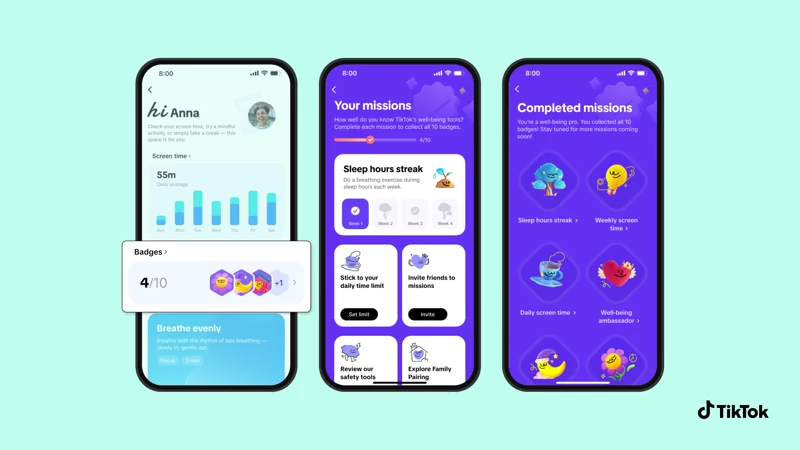
Social media was once marketed as a doorway to connection, creativity, and community.
However, doorway widened into an always-open portal where millions drift in and out without even noticing how long they've stayed. What began as a harmless way to share moments has quietly reshaped the way people think, rest, focus, and even relate to ourselves. For many, checking their phone stopped being a choice and became a reflex.
A small hit of excitement. A quick escape. A habit that follows them from morning light to late-night silence.
Among the endless feeds competing for attention, TikTok sits comfortably at the top.
Its design is almost hypnotic. Each swipe delivers something new and intensely tailored, keeping the mind hungry for the next clip. The algorithm learns faster than users forget that they're still scrolling, and before long, minutes blur into hours. It’s no surprise that for teens and adults alike, TikTok isn’t just entertainment anymore.
It’s routine. It’s instinct. For some, it’s a dependency they never meant to form.
Doomscrolling on TikTok is real. A plague. A quiet, modern sickness that doesn’t leave visible marks but drains people all the same.
Now, TikTok wants to end that.
Doomscrolling, which can be described as that familiar spiral when you know you should stop, yet you keep going, isn’t always about bad news.
Sometimes it’s the addictive chase itself, the never-ending stream of stimulation that keeps users locked in place long after the mind has checked out. It’s a cycle powered by curiosity, reinforced by algorithmic precision, and carried quietly into bedrooms, classrooms, and late nights when the world should be asleep.
As more lawmakers push for legal limits on how long teens and children can use social media, TikTok is fighting back.
But not by removing features, but by reimagining how screen time works. Rather than imposing hard lockouts, the company’s new Time & Well-being initiative leans into positive reinforcement, nudges, and digital self-care.
While user retention is one of the most valuable metrics for platforms like TikTok, the company needs to do something as more lawmakers push for legal limits on how long teens and children can use social media.
TikTok is fighting back, but not by removing features, but by reimagining how screen time works.
Rather than imposing hard lockouts, the company leans into positive reinforcement, nudges, and digital self-care.
In order to end that doomscrolling habit users develop, TikTok is giving users a kind of incentive, the TikTok way.

In a newsroom post, TikTok said that it has overhauled its old screen-time management page and replaced it with a dedicated 'Time & Well-being' hub. This space is designed not just to monitor usage but to help users reflect, reset, and intentionally use the app. Key features include:
- Affirmation Journal: More than 120 prompt cards users can use to set daily intentions. Users can download them or share them with others.
- Soothing sound generator: A built-in sound machine that plays ambient audio, like waves, rain, white noise, which can be useful for relaxation and sleep.
- Breathing Exercises: Guided mindful breathing routines, designed to help pause and reset.
The new section also features creators who share clear, practical tips on managing the app. They walk viewers through tools like screen time controls, ways to shape the For You feed, and options available through Family Pairing.
TikTok also launches new Well-being Missions. which are "short, fun tasks designed to help our community, and teens in particular, use technology with greater purpose and confidence."
As users complete missions, they can earn badges. This should help "encourage and reinforce mindful behaviors."
According to TikTok in an example, in order to finish the new Sleep Hours Mission, people simply need to stay away from TikTok during the night. They can also choose to meditate during these hours to earn their badge. The Mission runs for eight weeks, letting participants nurture their own Well being tree as they complete each stage. The concept grew from ideas shared by its Youth Council during their recent Summit in London.
Earning the daily screen time badge is straightforward. People set a screen time limit, then keep to the boundary they chose.
Then, the new weekly screen time Mission nudges people to review their weekly screen time report. It is meant to help them pause, reflect and become more conscious of how much time they actually spend on TikTok.
TikTok has also introduced a Well being Ambassador Mission that rewards those who encourage others to take part in the Well being Missions.
In all, these updates are especially focused on healthy habits.
Early testing shows these features are working well: people returned to the new well-being space more frequently than they did to the old screen-time menu, and the affirmation journal was especially popular.

TikTok’s approach here seems intentional, as the company has openly said that overly rigid controls may backfire, especially for teenagers. But rather than just restricting usage (like what most other platforms do with their well-being initiatives), TikTok leans on positive reinforcement: rewards, self-awareness tools, and in-app reminders.
On the one hand, TikTok’s strategy could be seen as smart: by offering positive nudges instead of only punitive limits, it tries to help users cultivate self-regulation, rather than just restricting them.
With more people returning to the new well-being space in early tests, the approach seems to have traction.
On the other hand, critics may argue that these are still cosmetic solutions, especially in the face of growing legislative pressure. After all, addicts may not care about earning badges, and that the "soft nudge" model is easy to override. And even with parental tools, not all families will use or enforce them, and not all teens will engage with the well-being hub in a meaningful way.
Regardless, the bigger picture is that, TikTok is gambling.
TikTok is clearly responding not only to mental health criticism but also to regulatory heat. Legislators in various countries are pushing for stricter rules on how long under-18s can use social apps. By launching a more holistic well-being toolkit, TikTok is signaling that it wants to be seen as a responsible actor: one that empowers, rather than simply polices.
From a policy perspective, this could be a clever move: if TikTok can show that it's already taking substantial steps to promote digital wellness, it may argue against overly restrictive regulation. But whether these features will satisfy regulators, or actually protect the most vulnerable users, is another question entirely.
